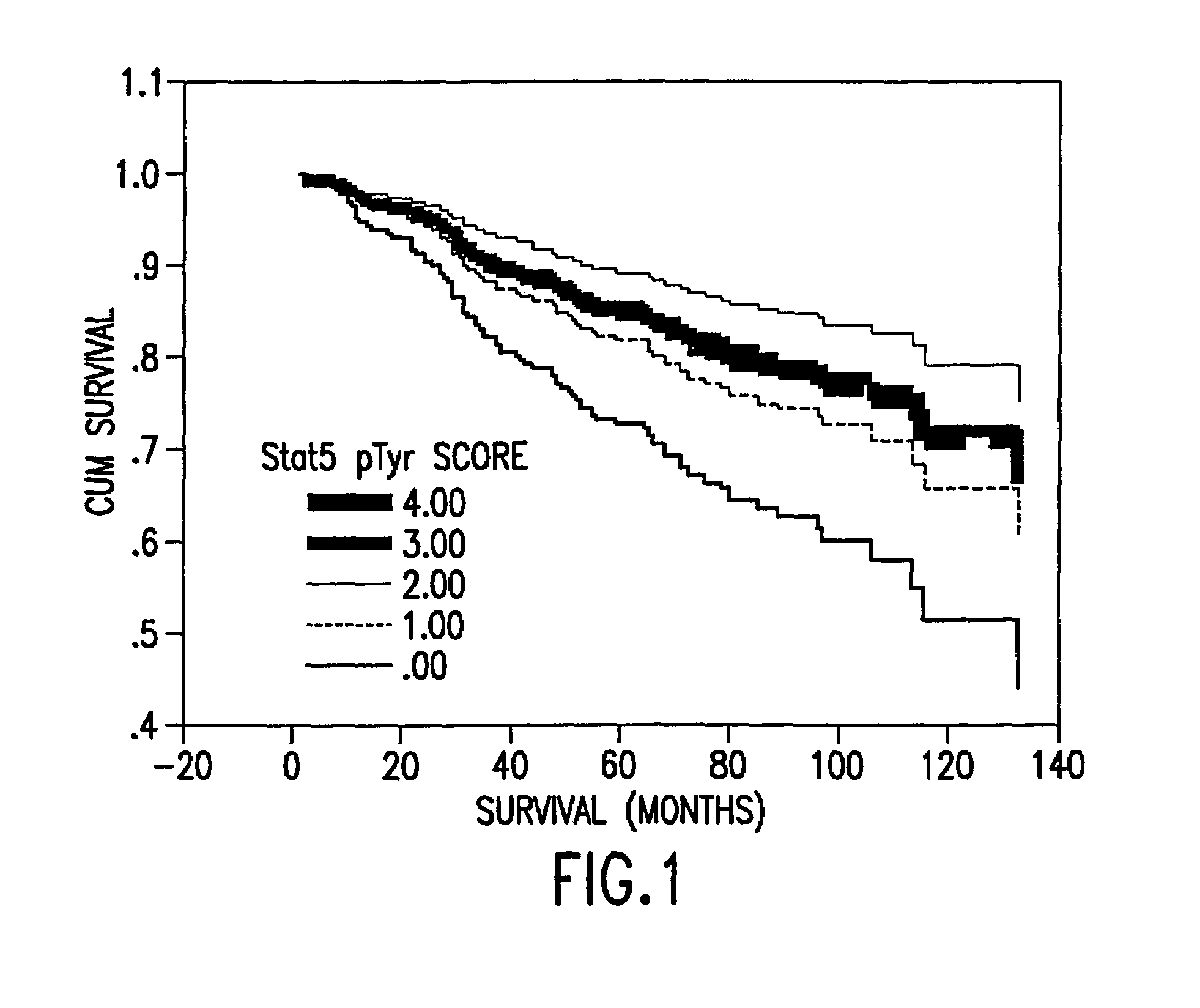Diagnostic and monitoring methods for cancer
a monitoring method and cancer technology, applied in the field of breast cancer diagnosis and monitoring methods, can solve the problems of inability to limited success of interventions, and inability to accurately predict the prognosis of er/pr status, so as to reduce the risk of breast cancer death and reduce the risk of metastatic diseas
- Summary
- Abstract
- Description
- Claims
- Application Information
AI Technical Summary
Benefits of technology
Problems solved by technology
Method used
Image
Examples
example 1
Analysis of Levels of Activated Stat5 in Breast Cancer to Predict Prognosis
[0149]It has been established in the present invention that activation of Stat5, a transcription factor which is constitutively activated in normal breast epithelial cells, is gradually lost in lesser differentiated human breast tumor cells. Based on analysis of human normal and malignant breast tissue samples, a positive correlation was observed between Stat5 activation and degree of cell differentiation. Cell differentiation, as measured by low histological grade, of a tumor is a known general prognostic factor for cancer. Tumors of higher grade, i.e. lower degree of tumor cell differentiation, is associated with poor prognosis. The prognostic value of Stat5 activation for breast cancer outcome therefore was examined. A simple procedure for antigen retrieval of tyrosine-phosphorylated Stat5 in formalin-fixed cells and tissues was established. The procedure validated the specificity of detection of antibodie...
example 2
Treatment of Breast Cancer
[0185]A sample of breast tissue from a patient with breast cancer or suspected of having breast cancer is obtained. The sample may be either a biopsy sample, a pathology sample obtained after a tumor has been removed from the breast or an archived sample previously obtained from the patient. The sample is analyzed similar to Example 1.
[0186]Based on analysis of levels of activated Stat5 the tumor sample, a treatment regime is determined using acceptable treatment alternatives known to those skilled in the art. These may include, but are not limited to, observation, mode of surgery, non-adjuvant therapies such as radiation, and adjuvant therapies such as tamoxifen or cytotoxic chemotherapy.
[0187]The invention has established that a positive Stat5 activation status in node-negative breast cancer is associated with a remarkably low risk for subsequent disease relapse and death from breast cancer within 10 years. Specifically, in patients who did not receive an...
example 3
Method for Screening Compounds
[0205]The pharmaceutical industry is interested in evaluating pharmaceutically useful compounds which act as growth factor agonists or antagonists. Tens of thousands of compounds per year need to be tested in an entry level or “high flux” screening protocol. Out of the thousands of compounds scrutinized, one or two will show some activity in the entry level assay. These compounds are then chosen for further development and testing. Ideally, a screening protocol would be automated to handle many samples at once, and would not use radioisotopes or other chemicals that pose safety or disposal problems. An antibody-based approach to evaluating desired or undesired drug regulation of transcription factor activities would provide these advantages and offer the added advantage of high selectivity.
[0206]In particular, antibodies that recognize activated Stat5 may be used to for screening drugs in various screening protocols. Generally, two approaches are used. ...
PUM
| Property | Measurement | Unit |
|---|---|---|
| pH | aaaaa | aaaaa |
| pH | aaaaa | aaaaa |
| pH | aaaaa | aaaaa |
Abstract
Description
Claims
Application Information
 Login to View More
Login to View More - R&D
- Intellectual Property
- Life Sciences
- Materials
- Tech Scout
- Unparalleled Data Quality
- Higher Quality Content
- 60% Fewer Hallucinations
Browse by: Latest US Patents, China's latest patents, Technical Efficacy Thesaurus, Application Domain, Technology Topic, Popular Technical Reports.
© 2025 PatSnap. All rights reserved.Legal|Privacy policy|Modern Slavery Act Transparency Statement|Sitemap|About US| Contact US: help@patsnap.com



